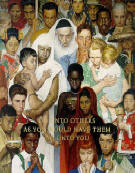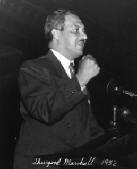
|
Brown vs. Topeka
Board of Education |
||||||||||||||||||||||||||||||||||||||||||||||||||||
|
|
||||||||||||||||||||||||||||||||||||||||||||||||||||
Brown Sisters Interview
1. From a child's standpoint, how did you feel being singled out for such a case? Because I was a minor (8 years old) I played a very limited role in what happened at the time. I did appear in court but did not have to testify. My father, of course, provided the testimony about my circumstances. The most I remember is that when the parents involved tried to enroll us in the all white schools and we were denied, my mother explained that it was because of the color of our skin. As a child I did not comprehend what difference that could possibly make. 2. What improvements in education today do you feel as a result of your willingness to stand up for your rights? We believe for our parents and others it took courage to get involved and to agree to participate. They ran the risk of loosing jobs personal injury. They believe what they were doing was right. This case put together by attorneys who then asked parents with school aged children to participate. We believe the results have been seen more in other areas of society such as public accommodations (hotels) and public transportation which were some of the most segregated situations. Education has been slow to company. The greatest improvement is an understanding of all people by learning about cultures different than our own. Multicultural education was unheard of before this took place. 3. What disappointments do you have about what you whished would happen and didn't? Our family sees that this country is still attempting to turn back the clock and keep a line drawn between races of people. We have fallen short of having equal educational opportunity for all children. 4. What hopes do you have for improvements in the rights of minority children in this decade? Our family thinks it would be wonderful if this country would make civil rights a priority to ensure that children in the elementary school today will have equal opportunities for themselves and their families in the future. 5. Why did your parents think the school you attended wasn't equal to others in Topeka? Can you give specific examples? The Topeka case was not about inequality. It was about equal access. The schools for black children were built by the same companies as those for white children. The teaching staff and materials were also equal with regard to their education and type of subjects taught. In fact one of the all black schools in Washington Elementary School had more teachers with Masters Degrees than and school in the city in general. This aspect of the Topeka case was proven during the fact finding portion of the case. The issue for black parents was the distance their children had to travel to attend school when there were schools in their neighborhoods. Neighborhoods in Topeka were integrated. People lived where they could afford to live. 6. Did and other black families feel the same as you did about the inequality in the Topeka school? Yes, the Topeka case actually involved a total of 13 families who filed suit in behalf of their children. 7. What made your parents file the suit? The local chapter of the National Association for the Advancement of Colored People (NAACP) recruited plaintiffs in order to have a case. My dad agreed to participate along with other families. 8. What did your friends think of the lawsuit? Did you lose any friends because of this? Were you threatened in any way after the lawsuit was started? As children none of us knew what was going on. When the case was settled in 1954 I was eleven and once again did not comprehend the meaning. We were not threatened some of the other plaintiffs were. 9. When you won the lawsuit, did you begin attending the school of your choice? If so, how were you treated by the other kids and teachers? No, in Topeka the Junior and Senior High Schools were already integrated. In the fall of 1954 I began 7th grade at Curtis Junior High School. I never attended Sumner Elementary School. In 1961 after the death of our father, and we moved back to the old neighborhood my sister (Cheryl) attended Sumner for 6th grade. 10. Did you church play any part in your parents decision to start the lawsuit? Did your church support your parents in this decision? The congregation of our church was supportive as individuals, no formal request was made for a unified church voice. 11. Did you feel like a celebrity during and after the lawsuit? Can you describe you feelings? Not really. At age 11 you are concerned about other things. I did not fully understand what had been accomplished by this case. My parents were low key and did not make an issue of this milestone. This case is named after my father: "Oliver L. Brown, et. al., vs. The Board of Education of Topeka" the et. al. means and others. 12. Do you think the Topeka schools still have room for improvement in the matter of equal education for all students? Can you give a specific example to support your answer? Yes. Unfortunately our society is still full of people who do not believe that we are all the same, with the same ability and the same ambitions. Some of these non-believers are the classroom teachers and school administrators. In order for all children to learn, those responsible for their education must believe in them. We have not reached that point. Not in Topeka or any place for that matter. 13. Looking back over the last 30 years since Brown, can you make any statements on the case's importance in history? The most significant outcome of this case was that it led the way for the rights of women, handicapped people and laws regarding age discrimination. 14. Why did you want to attend a white school? The school in question was only 4 blocks from my home as opposed to over 2 miles for the black school. 15. What role did you father play in taking the case to the Supreme Court? The plaintiffs had no role in the approach to the Supreme Court. The attorneys assumed that full responsibility. 16. How did you get involved with the NAACP lawyers to present your case to the Supreme Court? Testing the segregation policies of the school was the attorneys idea. Parents were asked to participate. 17. Who was the defendant in the lawsuit? The defendant would have been The Board of Education of Topeka. 18. How do you feel about the outcome of the Brown decision? There is still a lots of work to be done. Many schools are re-segregating. 19. What role did you play in the Brown II case? I agreed to lend my name to this case. 20. How did the white students feel about you when you attended an integrated school? Linda never attended the school in question. She was 11 years old in 1954 and going to junior high school. The junior high schools were already integrated. Please write any other comments you feel would be import. Please be aware that Brown is a group of cases and many people not one man and one child. Brown is made up of cases from Delaware, District of Columbia, South Carolina, Virginia and Kansas. These cases were combine under the title of Brown supposedly because this case arrived at the Supreme Court first.
Rachelle Brown Caitlin Alvarez
Brown, Linda and Cheryl. "Brown Foundation for Education Equity, Excellence and Research." 2/5/02
Mrs. Brown doesn't do interviews any longer, but the Brown Foundation for Education was kind enough to send a booklet of pervious interviews that she has done. |
|
|
||||||||||||||||||||||||||||||||||||||||||||||||||


